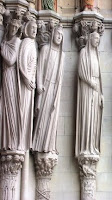Episcopal Schism
 I was raised Roman Catholic, and my wife was raised Lutheran. Back in 1972 when we got hitched, mixed marriages were still frowned upon, and we were met with raised eyebrows by skeptical family members. My cousin telling my wife that non-Catholics are heathens and going to hell is one example. My wife’s uncle telling me the only good fish-eater is a dead-fish eater is another…so much for the ecumenical spirit. Looking for common ground, my wife and I stumbled across the Episcopal Church and found a home. I loved its rich and beautiful liturgy and music, while its protestant attitude was comfortable to my wife. We attended an Episcopal Church for the next 28 years.
I was raised Roman Catholic, and my wife was raised Lutheran. Back in 1972 when we got hitched, mixed marriages were still frowned upon, and we were met with raised eyebrows by skeptical family members. My cousin telling my wife that non-Catholics are heathens and going to hell is one example. My wife’s uncle telling me the only good fish-eater is a dead-fish eater is another…so much for the ecumenical spirit. Looking for common ground, my wife and I stumbled across the Episcopal Church and found a home. I loved its rich and beautiful liturgy and music, while its protestant attitude was comfortable to my wife. We attended an Episcopal Church for the next 28 years.It is a relatively small United States denomination (2.1 million members) with its roots in the Church of England, separated by revolution. It believes in apostolic succession (the laying on of hands in an unbroken chain from St. Peter). Because of the American Revolution, the Church of England refused to consecrate American Bishops, and I have been told that the first “American” Bishop had to be consecrated by an Irish Roman Catholic Bishop, thus the line is unbroken.
While it is a small denomination in the United States, it is a member of the Anglican Communion whose worldwide membership tops 77 million people, making it the third largest Christian denomination in the world behind the Roman Catholics and collectively the Eastern Orthodox churches. The Anglican Communion is a confederation of national churches with the Archbishop of Canterbury in England its titular Primate, serving as the symbolic head of the communion. Translate: he doesn’t operate like the Pope. Power for the communion is bottom up rather than the top down, with various conferences and conventions held periodically to vote on Bishops, and issues of church doctrine within each of the member national churches, then within the Anglican communion itself.
In the United States, the power of the Episcopal Church is somewhat disproportionate to its size. Many of the founding fathers were originally members of the Church of England. Membership is heavily concentrated on the east coast in New York and around Washington DC and down into the south. St. John’s Episcopal Church, located across the street from the White House, is known as the Church of Presidents as most of our Presidents, including Barack Obama, have worshipped there. The National Cathedral is also Episcopalian, and the center of numerous non-denominational functions for all faiths, Christian or otherwise, including many American state funerals. The Episcopal Church is also one of the weightier landlords in the United States, owning numerous prime pieces of real estate, especially in New York City. That’s an Episcopal church at the top of Wall Street.
The doctrine of the church has always been a tad ambivalent. It is very tolerant of many diverse views, and runs the gambit from ultra conservative type believers to the loony left ideas of Bishop Spong, who makes the news from time to time on his interesting views of Christianity. This tolerance of diverse views, coupled with its history of progressive activism, has been a strength for the church, but is now proving to be its undoing. The tent may not be big enough…and it is the conservative wing that is being squeezed out.
Progressive issues began to rumble through the church in 1976 with the General Convention allowing the ordination of women as priests and bishops. Numerous members of the overall Anglican Communion did not recognize women priests, let alone women bishops. The first female bishop was ordained in 1989. Then in 2006, Katharine Jefferts Schori was elected the first female American presiding Bishop, and the battle was joined.
The first openly gay priest was ordained in 1989 by Bishop Spong, as the General Convention took up the issue of the role of gays in the church, as well as society. Beginning in 1976, the church slowly, but steadily liberalized its views towards homosexuality, but always maintained the position that marriage should be between heterosexuals.
Notwithstanding, Gene Robinson was consecrated in 2003 as the first openly gay Episcopal Bishop in New Hampshire, setting off a firestorm within the conservative wing of the church. The gay rights movement within the church reached its culmination this past week when the Lay Delegates to the General Convention followed the House of Bishops in approving the development of a liturgy to be used for gay couples…in effect providing de-facto church approval of gay marriage. It also approved resolutions clearly allowing gay priests and bishops within the church.
Over the past several years, the conservatives have not been silent. The American Episcopal Church has met with disapproval of the international Anglican Communion, many of the constituent members calling for the removal of the Episcopal Church from the Anglican Communion. The largest segment, as well as the fastest growing segment, of the Anglican Communion is in Africa. These folks tend to be extremely conservative, and have actively lobbied to have the United States church ostracized.
Within the United States, numerous Episcopal dioceses have seceded from the parent church. This group has applied for recognition from the Anglican Communion as the Anglican Church in North America, and has aligned itself with various Bishops throughout the world. What is troubling to the Episcopal Church is that these break-away dioceses are among the largest and wealthiest in the country, including the Diocese of Pittsburgh, the Diocese of Fort Worth, and the Diocese of San Joaquin. In addition, numerous churches within individual dioceses have broken away as is happening the Diocese of Northern Virginia.
The issues relating to the schism are many. At the spiritual level, it certainly has been a crisis of faith for all parties. Everything in the church’s activist and progressive history points to the doctrinal conclusion reached by the Episcopal Church. On the other hand, many individual members hold to the traditional belief that homosexuality is a sin. On the other hand, the progressives within the church claim there never was any doctrine relating to homosexuality. There is always an “on the other hand.” I will leave that issue to one’s own conscience and one’s own beliefs.
The more interesting issue is what happens to the real estate. There are conflicting decisions as to who owns the real estate of the breakaway dioceses, but the general rule seems to be that it belongs to the national Episcopal Church rather than the dioceses or the breakaway parishes. Ultimately, that issue will be decided by the US Supreme Court if it ever gets that far. But if the Anglican Communion throws the Episcopal Church out…the courts could say that a rogue group of people took the church over, and the alignments made between the American parishes/dioceses and the Episcopal Church, which are the basis of current law, were broken when the Anglican Communion severed the relationship.
There is a long way to go before it reaches that stage. However, the reluctance of both sides to look for mutual ground for the church’s preservation leads me to conclude that this will be death by a thousand cuts for this proud and historic religion. I hope that God provides guidance to these folks dealing with difficult issues.
Although for numerous reasons other than the above, my wife and I have been attending a Lutheran church for the past 11 years. But it is sad to see this sort of thing happen to what I consider to be my home faith.


Comments
as you well know, the cathlic american church is facing a problem as well. as priests and laity become ever scarcer especially in decaying urban areas, what happens to the real estate and all the art of these glorious houses of worship? Who owns these buildings and will they be sold on the open market and where do the proceeds go? There will be splintering and hard feelings among parishioners when the neighborhood parish and or school building gets shuttered or is sold to a thriving pentacostal or non denominational fellowship. Maybe there will be a roman catholic schism in america, eh?
Blessings on you both, we had to leave Diocese of Northern IL (Really Chicago) after 20+ years for an AMiA church. Not all we wanted but they love us, and our kids. Half the ECUSA parish church left in the midst of a building program, personal attacks on Rector after the Rector left--ugly. My Dad referred me to your cite--lives and worked in Ytown for many years. Yes many problems in RC church as well. AmiA and the churches that formed a new Diocese in North America will soon have to sort out Woman's Ordination, we'll see how long they stay united... so if I had to move on I really like what I hear out of The new Arch-Bishop of the Orthodox Church in America-- Metropolitan Jonah (Baptised Episcopalian as a youth, chrismated into OCA as College student), Orthodox, honest about their churches short comings but repentant, forward looking, and growing, thats always a good sign. Pax Steve